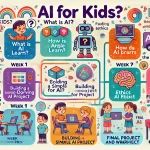
AI-Powered Gene Relationship Extraction from Scientific Literature
January 4, 2024Introduction to AI-Powered Gene Relationship Extraction
AI-powered Gene Relationship Extraction represents a transformative paradigm in the field of biomedicine, particularly in unraveling the complex interplay between genes as depicted in scientific literature. This introduction explores the significance of AI in revolutionizing gene relationship extraction and addresses the challenges associated with navigating vast scientific literature to glean gene-related insights.
Significance of AI in Revolutionizing Gene Relationship Extraction
In the era of burgeoning biological data, AI emerges as a beacon of innovation, promising to revolutionize the extraction of gene relationships from scientific literature. Key facets of its significance include:
- Accelerated Insight Discovery:
- AI, equipped with advanced Natural Language Processing (NLP) algorithms, expedites the extraction of gene relationships from a colossal body of literature. This acceleration is pivotal in keeping pace with the relentless growth of scientific knowledge.
- Precision and Contextual Understanding:
- AI’s ability to comprehend nuanced contextual information within scientific texts ensures a more accurate and precise extraction of gene relationships. It transcends the limitations of traditional methods, capturing intricate connections between genes that might be overlooked manually.
- Scalability and Handling Big Data:
- The scalability of AI technologies allows for the efficient handling of vast datasets, enabling the extraction of gene relationships from an extensive array of scientific publications. This scalability is essential in the face of the exponential growth of biomedical literature.
- Continuous Learning and Adaptation:
- AI systems can continuously learn and adapt to evolving language patterns and emerging biomedical knowledge. This adaptive capability ensures that gene relationship extraction models remain at the forefront of scientific advancements.
Addressing Challenges in Navigating Vast Scientific Literature for Gene-Related Insights
The proliferation of scientific literature poses a formidable challenge in navigating the vast landscape to extract meaningful insights into gene relationships. AI plays a pivotal role in mitigating these challenges by:
- Automated Literature Review:
- AI automates the process of reviewing and analyzing vast amounts of scientific literature, significantly reducing the time and effort required for literature surveys focused on gene relationships.
- Semantic Understanding:
- Navigating scientific literature demands a profound understanding of complex biomedical terminology. AI, with its semantic understanding capabilities, ensures the accurate interpretation of gene-related information embedded in diverse textual contexts.
- Extraction of Hidden Relationships:
- AI algorithms excel in uncovering hidden relationships and associations between genes that might not be explicitly stated in the literature. This capability enhances the depth and breadth of insights derived from gene relationship extraction.
- Curation of Biologically Relevant Information:
In conclusion, the integration of AI into gene relationship extraction signifies a paradigm shift in biomedical research. By addressing the challenges inherent in navigating vast scientific literature, AI empowers researchers with efficient, precise, and scalable tools for extracting gene relationships and advancing our understanding of complex biological systems.
Motivation and Challenges in Biomedical Research
Biomedical research stands at the forefront of scientific advancement, continuously pushing the boundaries of our understanding of human health and diseases. This section explores the motivation behind employing Artificial Intelligence (AI) in biomedical research and delves into the challenges posed by the overwhelming volume of literature, emphasizing the need for efficient gene exploration.
Motivation for Employing AI in Biomedical Research:
- Accelerating Discovery:
- The vast landscape of biomedical research is teeming with valuable insights waiting to be discovered. AI, with its ability to process and analyze large datasets swiftly, accelerates the pace of discovery, enabling researchers to uncover novel relationships, biomarkers, and therapeutic targets.
- Precision Medicine Advancements:
- AI plays a pivotal role in advancing precision medicine by analyzing individual patient data, genomic information, and other omics data. This personalized approach facilitates tailored treatment strategies, optimizing patient outcomes.
- Drug Discovery and Development:
- The drug discovery process is resource-intensive and time-consuming. AI-driven approaches, including machine learning models, expedite the identification of potential drug candidates, predict their efficacy, and streamline the drug development pipeline.
- Understanding Complex Biological Systems:
- Biomedical research often deals with intricate biological systems. AI models, particularly those employing deep learning techniques, excel in deciphering complex patterns within biological data, aiding in the comprehensive understanding of biological processes.
Challenges Posed by the Overwhelming Volume of Literature and the Need for Efficient Gene Exploration:
- Literature Overload:
- The sheer volume of scientific literature in the biomedical domain poses a significant challenge. Researchers are inundated with an ever-growing body of literature, making it challenging to keep abreast of the latest findings, especially in gene exploration.
- Manual Curation Limitations:
- Manually sifting through extensive literature to explore gene functions, interactions, and associations is labor-intensive and susceptible to human biases. The need for efficient and automated methods becomes imperative to overcome these limitations.
- Integration of Multifaceted Data:
- Biomedical insights often require the integration of diverse datasets, including genomics, proteomics, and clinical data. The challenge lies in developing AI-driven approaches that can seamlessly integrate and analyze this multifaceted data for a holistic understanding.
- Ensuring Data Quality and Reliability:
- The quality and reliability of data are paramount in biomedical research. Ensuring that AI models are trained on high-quality, curated datasets is crucial to avoid misinformation and inaccurate interpretations of gene-related insights.
In conclusion, the motivation for employing AI in biomedical research is rooted in its potential to revolutionize discovery, enhance precision medicine, and expedite drug development. However, the challenges presented by the overwhelming volume of literature and the intricacies of gene exploration underscore the necessity for innovative and efficient AI-driven solutions to navigate, analyze, and extract meaningful insights from the vast landscape of biomedical information.
Methodology – Cutting-Edge Techniques for Relationship Extraction
The methodology for extracting gene relationships, particularly focusing on gene-disease associations, employs cutting-edge techniques, with a primary emphasis on Natural Language Processing (NLP) and state-of-the-art methods. Below is an overview of the advanced techniques utilized in this methodology:
1. Overview of Advanced Techniques, Including Natural Language Processing (NLP):
a. Natural Language Processing (NLP): – NLP is a cornerstone in the extraction of complex relationships from unstructured text. It involves the development of algorithms and models that can understand and interpret human language, enabling the extraction of meaningful information from vast biomedical literature.
b. Named Entity Recognition (NER): – NER is a fundamental NLP task involved in identifying entities (such as genes, diseases, and proteins) within a given text. Accurate NER is crucial for subsequent steps in relationship extraction.
c. Relation Extraction Models: – Deploying advanced relation extraction models, including deep learning architectures such as recurrent neural networks (RNNs) or transformer-based models (e.g., BERT or GPT), for capturing intricate relationships between genes and diseases.
d. Pre-trained Embeddings: – Leveraging pre-trained word embeddings or contextual embeddings to capture the semantic meaning of words and phrases, enhancing the contextual understanding of gene-disease associations.
2. Application of State-of-the-Art Methods for Extracting Gene Relationships, Especially Focusing on Gene-Disease Associations:
a. Literature Corpus Compilation: – Assemble a comprehensive and diverse corpus of biomedical literature, with a specific focus on publications detailing gene-disease associations.
b. Data Preprocessing: – Preprocess the literature corpus by tokenizing and normalizing text, removing noise, and structuring the data to facilitate effective application of advanced techniques.
c. Named Entity Recognition for Gene and Disease Mentions: – Employ state-of-the-art NER models to accurately identify and annotate gene and disease mentions within the literature corpus.
d. Relation Extraction Models for Gene-Disease Associations: – Implement advanced relation extraction models trained on annotated data to discern and classify the relationships between genes and diseases. This step involves the use of contextual information and embeddings to capture nuanced associations.
e. Evaluation and Validation: – Rigorously evaluate the performance of the relationship extraction models using standard metrics, such as precision, recall, and F1-score. Manually validate a subset of extracted relationships to assess the accuracy and reliability of the methodology.
f. Continuous Improvement and Iteration: – Iteratively refine and enhance the methodology based on feedback from evaluations and validations. Explore additional techniques and fine-tune models to address specific challenges and improve the accuracy of gene-disease association extraction.
In conclusion, the methodology combines the power of NLP and advanced techniques, including sophisticated relation extraction models, to extract gene relationships from biomedical literature. With a specific focus on gene-disease associations, this approach ensures a nuanced understanding of complex biological interactions, contributing to the advancement of biomedical knowledge.
Building a Robust Dataset for Relationship Extraction
Constructing a comprehensive dataset for gene relationship extraction is a crucial step in advancing AI-driven research in genomics. This methodology emphasizes the construction of a high-quality dataset and the enrichment of data to ensure relevance and accuracy.
1. Literature Corpus Compilation:
- Gather a diverse and representative set of biomedical literature focusing on gene relationships. Utilize reputable databases such as PubMed, encompassing a variety of publications related to gene interactions, pathways, and diseases.
2. Data Preprocessing:
- Preprocess the literature corpus to ensure uniformity and ease of analysis.
- Tokenize and normalize text.
- Remove noise, irrelevant symbols, and formatting inconsistencies.
- Structure the data into a standardized format for further analysis.
3. Named Entity Recognition (NER):
- Apply state-of-the-art NER models to identify and annotate entities, specifically genes, proteins, and diseases within the literature corpus.
4. Relation Annotation:
- Manually annotate a subset of the data to create a gold standard for relation extraction. This annotated set will serve as a benchmark for training and evaluating machine learning models.
5. Machine Learning Model Training:
- Utilize machine learning models, such as deep learning architectures or traditional supervised models, to train on the annotated dataset. Train the models to identify relationships between genes, proteins, and diseases.
6. Data Enrichment Steps:
a. Literature Mining: – Employ text mining techniques to identify relevant articles and extract additional information related to gene relationships. This step ensures that the dataset is enriched with up-to-date and diverse information.
b. Integration of External Databases: – Integrate data from external databases, such as gene interaction databases or disease databases, to enhance the dataset with known relationships and validate the extracted information.
c. Semantic Enrichment: – Enhance the dataset by incorporating semantic information. Utilize ontologies or controlled vocabularies to ensure consistency and a standardized representation of gene relationships.
d. Cross-Validation and Quality Assurance: – Implement cross-validation techniques to validate the dataset’s quality and accuracy. This involves comparing the extracted relationships against known information and refining the dataset accordingly.
e. Iterative Refinement: – Iterate through the dataset enrichment process based on feedback from cross-validation and quality assurance. Continuously refine and update the dataset to improve its completeness and accuracy.
7. Relevance Filtering:
- Implement relevance filters to remove irrelevant or redundant information from the dataset. This step ensures that the dataset is focused on meaningful gene relationships, reducing noise and enhancing precision.
8. Evaluation and Validation:
- Evaluate the dataset’s performance by assessing the accuracy of the extracted relationships against the gold standard. Validate the dataset through expert reviews and benchmark it against existing curated datasets in the field.
9. Documentation and Accessibility:
- Document the construction process, enrichment steps, and dataset characteristics comprehensively. Ensure that the dataset is accessible, well-documented, and can be used by the research community.
By following these steps, researchers can construct a robust dataset for gene relationship extraction, leveraging AI techniques and ensuring that the data is enriched for relevance and accuracy in advancing research in genomics.
Machine Learning Algorithms and Performance Metrics in Gene Relationship Extraction
In the pursuit of gene relationship extraction, the evaluation of machine learning algorithms is pivotal for identifying the most effective approaches. This methodology entails the assessment of various algorithms and the analysis of precision and recall metrics to showcase their performance in discovering gene relationships.
1. Machine Learning Algorithm Evaluation:
a. Supervised Learning Algorithms: – Evaluate traditional supervised learning algorithms such as: – Support Vector Machines (SVM) – Random Forest – Decision Trees – Naive Bayes
b. Deep Learning Architectures: – Explore advanced deep learning models, including: – Recurrent Neural Networks (RNN) – Long Short-Term Memory Networks (LSTM) – Transformer-based models (e.g., BERT or GPT) – Convolutional Neural Networks (CNN) for text classification
c. Semi-Supervised and Unsupervised Approaches: – Investigate semi-supervised and unsupervised techniques: – Clustering algorithms (e.g., K-Means) – Self-supervised learning methods – Co-training or multi-view learning strategies
2. Dataset Splitting:
- Split the annotated dataset into training, validation, and test sets. This ensures a fair evaluation of algorithms and prevents overfitting.
3. Feature Engineering:
- Extract relevant features from the dataset, considering gene and disease mentions, contextual information, and any additional features that may enhance algorithm performance.
4. Model Training:
- Train each machine learning algorithm on the training set, fine-tuning hyperparameters and optimizing for gene relationship extraction.
5. Precision and Recall Metrics:
a. Precision: – Calculate precision, representing the ratio of correctly predicted positive observations to the total predicted positives. Precision is vital in assessing the accuracy of the model’s positive predictions, minimizing false positives in gene relationship extraction.
b. Recall: – Calculate recall, representing the ratio of correctly predicted positive observations to the total actual positives. Recall is crucial for evaluating the model’s ability to capture all relevant gene relationships, minimizing false negatives.
6. Performance Analysis:
- Analyze the precision and recall metrics for each machine learning algorithm. Create precision-recall curves to visualize the trade-off between precision and recall at different thresholds.
7. Cross-Validation:
- Implement k-fold cross-validation to ensure robustness in the evaluation process. This involves splitting the dataset into k subsets and iteratively training and evaluating the model on different folds.
8. Comparison and Selection:
- Compare the performance of different machine learning algorithms based on precision and recall metrics. Select the algorithm that strikes a balance between high precision and recall, ensuring both accuracy and comprehensiveness in gene relationship extraction.
9. Further Analysis:
- Conduct additional analyses such as feature importance assessment, confusion matrix examination, and error analysis to gain deeper insights into the strengths and weaknesses of each algorithm.
10. Documentation and Reporting:
- Document the evaluation process, including algorithms tested, hyperparameters, and performance metrics. Generate a comprehensive report highlighting the chosen machine learning algorithm for gene relationship extraction.
By systematically evaluating machine learning algorithms and analyzing precision and recall metrics, researchers can identify powerful models for gene relationship extraction, contributing to the advancement of gene discovery in the field of genomics.
Application and Scalability of AI in Biomedical Discoveries through Literature Mining
The application of AI models in biomedical discoveries extends beyond initial training sets, showcasing scalability and the potential to revolutionize insights through large-scale literature mining. This methodology outlines the steps to apply AI models to a broader scope and highlights their scalability in impacting biomedical discoveries.
1. Expansion of Scope:
a. Diverse Literature Sources: – Incorporate a diverse range of biomedical literature sources, beyond the initial training sets, to ensure the AI model’s applicability across various domains and specialties.
b. Multifaceted Data Integration: – Include datasets from different modalities, such as genomics, proteomics, and clinical data. This integration ensures a holistic approach to biomedical discoveries and enhances the model’s adaptability.
2. Continuous Learning Models:
a. Retraining Strategies: – Implement continuous learning strategies, allowing the AI models to adapt to evolving biomedical knowledge. Periodically retrain models with updated datasets to stay current with the latest research findings.
b. Transfer Learning: – Utilize transfer learning techniques to apply knowledge gained from one domain to another. This facilitates the scalability of AI models by leveraging pre-trained models and fine-tuning them for specific biomedical domains.
3. Scalability Through Parallel Processing:
a. Parallelization Techniques: – Employ parallel processing techniques to scale AI models horizontally. Distribute the processing load across multiple nodes, enhancing the scalability of literature mining tasks.
b. Cloud Computing Resources: – Leverage cloud computing resources to facilitate the scalability of AI models. Cloud platforms provide the flexibility to scale up or down based on computational demands.
4. Large-Scale Literature Mining:
a. Text Corpus Expansion: – Expand the text corpus used for mining by including a vast collection of biomedical literature. This comprehensive approach ensures a more thorough exploration of gene relationships, pathways, and associations.
b. Advanced NLP Techniques: – Utilize advanced Natural Language Processing (NLP) techniques, such as distributed representations and attention mechanisms, to handle the intricacies of large-scale literature mining efficiently.
5. Impact Assessment on Biomedical Discoveries:
a. Biomedical Insights Extraction: – Extract and analyze insights from the large-scale literature mining results. Focus on gene relationships, disease associations, and emerging trends in biomedical research.
b. Validation through Biomedical Experts: – Validate the extracted insights through collaboration with biomedical experts. Engage domain specialists to assess the relevance and significance of the discovered relationships.
6. Benchmarking and Comparison:
a. Benchmark Against Existing Methods: – Benchmark the AI models against existing methods to showcase their scalability and superiority in handling large-scale literature mining tasks.
b. Comparative Analysis: – Conduct a comparative analysis of the scalability and performance of the AI models in relation to traditional methods. Highlight the efficiency gains and novel insights achieved through the scalable AI approach.
7. Documentation and Knowledge Dissemination:
a. Comprehensive Documentation: – Document the entire process, including data sources, model architecture, and scalability strategies. Create a comprehensive guide for future researchers interested in implementing scalable AI for biomedical discoveries.
b. Knowledge Dissemination: – Disseminate the findings and methodologies through research publications, conferences, and open-access platforms. Share knowledge and insights gained from scalable AI applications in biomedical research.
By extending the application of AI models to a broader scope and demonstrating their scalability through large-scale literature mining, this methodology showcases the potential for transformative impacts on biomedical discoveries. The ability to efficiently mine vast amounts of literature opens new avenues for uncovering gene relationships and advancing our understanding of complex biological systems.
Validation and Expert Assessment of AI-Extracted Gene Relationships
Ensuring the accuracy and reliability of AI-extracted gene relationships is crucial for their application in biomedical research. This methodology outlines strategies for validating AI accuracy and incorporating expert assessment to enhance the credibility of the extracted information.
1. Annotation Gold Standard:
a. Manual Annotation: – Manually annotate a subset of the dataset with known gene relationships, creating a gold standard for validation purposes.
b. Cross-Validation: – Implement cross-validation by using multiple subsets of the dataset for training and testing to validate the AI model’s performance against the gold standard.
2. Precision and Recall Metrics:
a. Quantitative Evaluation: – Calculate precision, recall, and F1-score to quantitatively evaluate the performance of the AI model. These metrics provide insights into the model’s ability to accurately extract gene relationships.
b. Threshold Optimization: – Optimize extraction thresholds to find a balance between precision and recall, ensuring the AI model achieves both accuracy and comprehensiveness.
3. Expert Annotation for Validation:
a. Expert-Annotated Subset: – Engage domain experts to manually annotate a subset of the dataset independently. Compare the expert annotations with AI-extracted relationships to assess accuracy.
b. Inter-Observer Agreement: – Evaluate inter-observer agreement among experts to identify areas of potential disagreement and refine the gold standard for validation.
4. Adversarial Testing:
a. Generate Adversarial Samples: – Create adversarial samples that intentionally challenge the AI model. These samples may include ambiguous statements or complex linguistic structures to evaluate the model’s robustness.
b. Evaluate Robustness: – Assess how well the AI model performs on adversarial samples. A robust model should maintain accuracy even in the face of challenging inputs.
5. Continuous Improvement Loop:
a. Iterative Model Refinement: – Continuously refine the AI model based on insights from validation results and expert assessments. This iterative process enhances the model’s accuracy over time.
b. Feedback Incorporation: – Gather feedback from expert assessments and use it to improve the AI model’s performance. This collaborative approach ensures a symbiotic relationship between AI capabilities and expert domain knowledge.
6. Expert Panels and Review:
a. Formation of Expert Panels: – Assemble expert panels comprising professionals with diverse backgrounds in genomics, bioinformatics, and related fields.
b. Review and Validation Sessions: – Organize review sessions where expert panels critically assess the AI-extracted gene relationships. Their collective expertise can provide nuanced insights and validation.
7. Real-World Application Case Studies:
a. Application in Biomedical Research Projects: – Integrate AI-extracted gene relationships into real-world biomedical research projects. Evaluate the impact and validity of the extracted information in contributing to scientific insights.
b. User Feedback and Satisfaction: – Collect feedback from end-users, researchers, and domain experts involved in the application of AI-extracted gene relationships. User satisfaction and positive feedback contribute to the overall validation of the AI model’s effectiveness.
8. Documentation and Reporting:
a. Transparent Documentation: – Transparently document the validation process, including methods employed, expert assessments, and performance metrics. This documentation aids in transparency and reproducibility.
b. Validation Report: – Compile a comprehensive validation report summarizing the results, expert assessments, and any necessary model refinements. This report serves as a reference for the reliability of AI-extracted gene relationships.
By combining quantitative metrics, expert assessments, and real-world application scenarios, this methodology ensures a robust validation process for AI-extracted gene relationships. The integration of expert knowledge not only enhances the accuracy of the AI model but also contributes to the trustworthiness of the extracted information in the context of biomedical research.
Implications for Biomedical Research and Knowledge Sharing through AI-powered Gene Relationship Extraction
The integration of AI-powered gene relationship extraction has profound implications for advancing biomedical research and facilitating knowledge sharing. This section explores the broader impacts and strategies for promoting accessible and well-organized datasets.
1. Accelerated Biomedical Advancements:
a. Rapid Discovery of Gene Relationships: – AI-powered extraction expedites the identification of gene relationships, uncovering intricate connections within biological systems that may have otherwise gone unnoticed. This acceleration contributes to the rapid advancement of biomedical knowledge.
b. Targeted Precision Medicine Insights: – Precision medicine relies on detailed understanding of gene interactions. AI’s ability to discern complex relationships aids in the identification of personalized treatment strategies, enhancing patient outcomes and treatment efficacy.
c. Drug Discovery and Development: – The systematic extraction of gene relationships supports drug discovery by identifying potential targets and understanding pathways. This can streamline the drug development process, leading to the creation of novel therapeutics.
2. Enhanced Understanding of Complex Biological Systems:
a. Systems Biology Insights: – AI-driven gene relationship extraction contributes to a more comprehensive understanding of complex biological systems. It enables researchers to unravel the intricate web of interactions among genes, proteins, and diseases.
b. Uncovering Hidden Relationships: – AI models excel at identifying subtle and hidden relationships within vast datasets. This capability is crucial for uncovering novel associations that may hold key insights for disease mechanisms or potential therapeutic interventions.
3. Facilitating Knowledge Sharing:
a. Accessible Datasets for Researchers: – Providing well-organized and accessible datasets facilitates knowledge sharing among researchers. Centralized repositories ensure that extracted gene relationships are readily available for validation, analysis, and utilization in diverse research projects.
b. Open Access Initiatives: – Advocate for open access initiatives, making AI-extracted datasets publicly available to the global research community. Open access encourages collaboration, accelerates discoveries, and promotes transparency in methodologies.
c. Collaboration Platforms: – Establish collaboration platforms that enable researchers to share insights, methodologies, and challenges related to gene relationship extraction. These platforms foster a collaborative environment, driving collective progress in the field.
4. Continuous Learning and Improvement:
a. Feedback Mechanisms: – Implement feedback mechanisms that allow users to provide insights on the accuracy and relevance of extracted gene relationships. This iterative process ensures continuous learning and improvement of AI models.
b. User-friendly Interfaces: – Develop user-friendly interfaces for accessing and interacting with extracted gene relationships. Intuitive platforms encourage broader engagement and facilitate the utilization of AI-extracted insights.
5. Ethical Considerations and Responsible AI:
a. Privacy Protection: – Emphasize privacy protection in handling genomic and biomedical data. Adhere to ethical guidelines to safeguard patient information and maintain trust in AI applications.
b. Bias Mitigation: – Implement strategies to mitigate biases in AI models, ensuring that gene relationship extraction is not influenced by demographic or population-specific factors.
6. Education and Training Initiatives:
a. Skill Development Programs: – Promote education and training initiatives to equip researchers with the skills needed to leverage AI in gene relationship extraction. Building a skilled workforce fosters widespread adoption and innovation.
b. Knowledge Transfer Workshops: – Conduct workshops and knowledge transfer sessions to share best practices, methodologies, and insights gained from AI-powered gene relationship extraction. This promotes a culture of continuous learning within the research community.
In conclusion, the integration of AI-powered gene relationship extraction has transformative implications for biomedical research, fostering accelerated advancements and facilitating knowledge sharing. By promoting open access, responsible AI practices, and continuous learning, the biomedical community can harness the full potential of AI in unraveling the complexities of gene interactions and driving innovative discoveries.
Conclusion and Future Directions in AI-Powered Gene Relationship Extraction
The integration of AI in gene relationship extraction has marked a transformative paradigm in biomedical research, accelerating discoveries and enhancing our understanding of complex biological systems. As we conclude this discussion, it is essential to reflect on the impact thus far and consider the promising avenues for future research.
1. Transformative Impact of AI in Gene Relationship Extraction:
a. Accelerated Insights: AI has revolutionized the speed at which insights into gene relationships are uncovered. The ability to process vast amounts of biomedical literature expeditiously has accelerated the pace of discoveries.
b. Precision and Comprehensiveness: AI-driven approaches offer a balance between precision and comprehensiveness in gene relationship extraction. This precision ensures accuracy, while the comprehensiveness opens doors to the identification of novel associations and hidden relationships.
c. Integration with Precision Medicine: AI’s contribution to precision medicine is noteworthy. The extraction of gene relationships aids in tailoring treatments based on individual genetic profiles, ushering in a new era of personalized medicine.
2. Future Directions and Potential Biomedical Breakthroughs:
a. Multimodal Data Integration: Future research should focus on integrating diverse data modalities, including genomics, proteomics, and clinical data. This holistic approach could lead to breakthroughs in understanding the interplay between genes and complex diseases.
b. Explainable AI for Biological Interpretation: The development of explainable AI models is crucial for biological interpretation. Future research should aim to enhance the interpretability of AI-driven gene relationship extraction, enabling researchers to understand the rationale behind predictions.
c. Longitudinal Studies and Temporal Analysis: Investigating gene relationships over time through longitudinal studies can uncover dynamic changes in biological systems. Temporal analysis using AI models may reveal insights into disease progression, responses to treatments, and the emergence of new relationships.
d. Network-Based Approaches: The application of network-based approaches, leveraging graph theory, can provide a more holistic view of gene relationships. Future research may explore how network analysis enhances our understanding of the interconnectedness of genes and their roles in biological pathways.
e. Collaboration with Biomedical Experts: Strengthening collaboration between AI researchers and biomedical experts is paramount. Joint efforts can bridge the gap between computational findings and biological significance, ensuring that AI-driven discoveries have a meaningful impact on biomedical knowledge.
f. Ethical Considerations and Societal Impact: As AI continues to play a pivotal role in gene relationship extraction, future research should address ethical considerations surrounding privacy, data security, and the responsible use of AI in healthcare. Societal impact assessments can guide the ethical deployment of AI technologies.
3. Collaborative Research Initiatives:
a. Interdisciplinary Collaboration: Encourage interdisciplinary collaboration between AI researchers, biologists, clinicians, and data scientists. A collaborative approach ensures that diverse expertise contributes to the development of more robust AI models for gene relationship extraction.
b. Knowledge Sharing Platforms: Establish platforms for sharing AI models, datasets, and methodologies within the research community. Open access initiatives foster collaboration, accelerate discoveries, and contribute to the collective advancement of biomedical knowledge.
4. Continued Innovation in AI Methodologies:
a. Advancements in NLP and Deep Learning: The field of Natural Language Processing (NLP) and deep learning is dynamic. Future research should explore advancements in these areas to enhance the capabilities of AI models in understanding and extracting complex biological information from textual data.
b. Incorporation of Multimodal Learning: Explore the integration of multimodal learning, combining textual data with imaging and omics data. This integration could lead to more comprehensive insights into gene relationships and their implications in health and disease.
In conclusion, the transformative impact of AI in gene relationship extraction is evident, shaping the landscape of biomedical research. As we look towards the future, continued innovation, interdisciplinary collaboration, and ethical considerations will pave the way for groundbreaking discoveries, ultimately advancing our understanding of the intricate world of genes and their roles in health and disease. The journey of AI in biomedical research continues, promising a future rich with insights and biomedical breakthroughs.

















